七下 Unit 9 What does he look like? Section B 2a-2c课件(共31张PPT)
文档属性
| 名称 | 七下 Unit 9 What does he look like? Section B 2a-2c课件(共31张PPT) |  | |
| 格式 | pptx | ||
| 文件大小 | 2.1MB | ||
| 资源类型 | 教案 | ||
| 版本资源 | 人教新目标(Go for it)版 | ||
| 科目 | 英语 | ||
| 更新时间 | 2023-05-11 06:12:02 | ||
图片预览



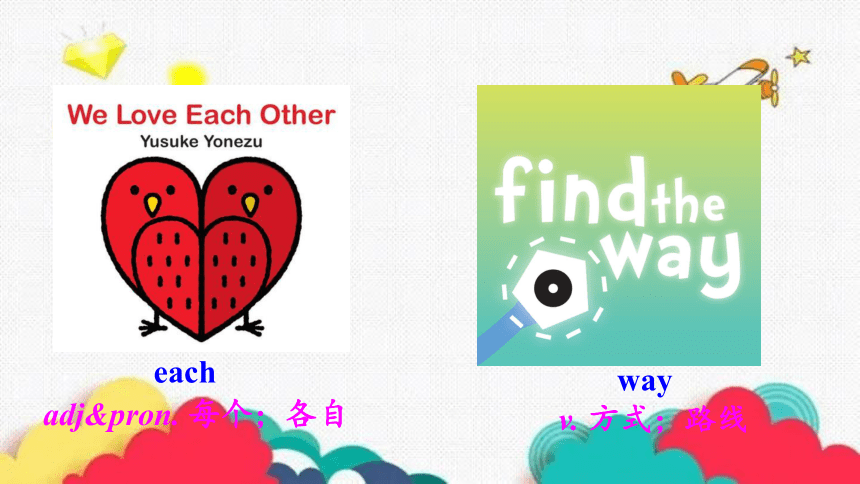
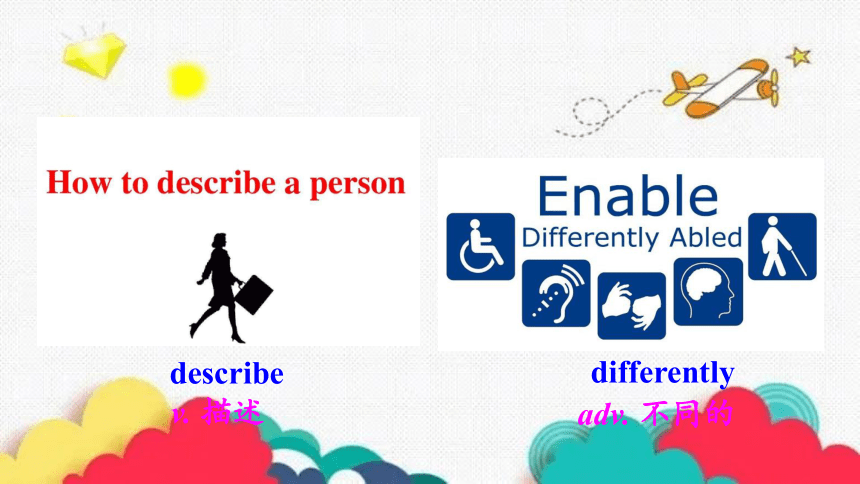

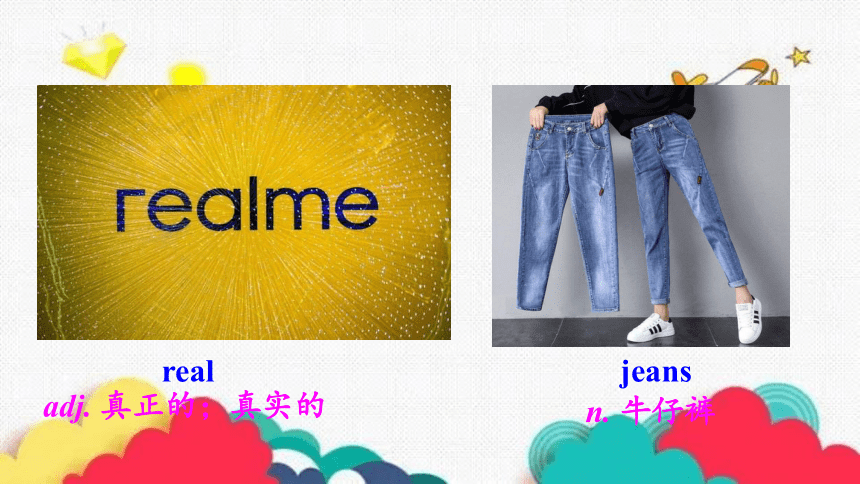
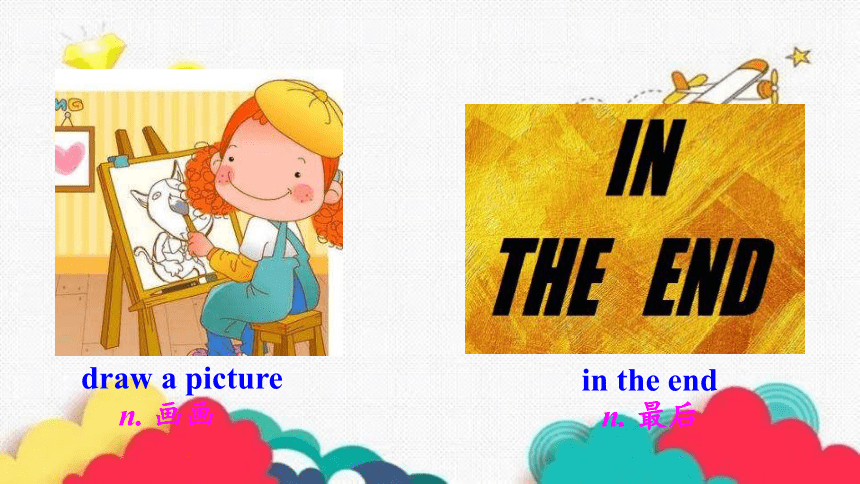
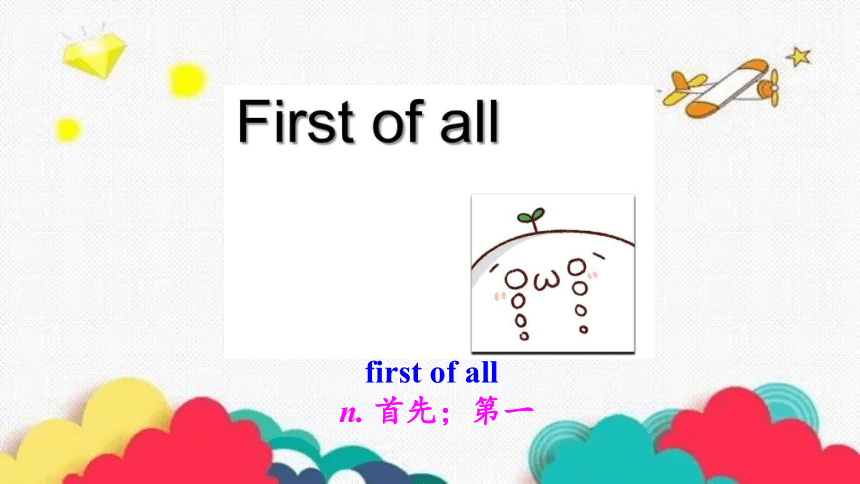
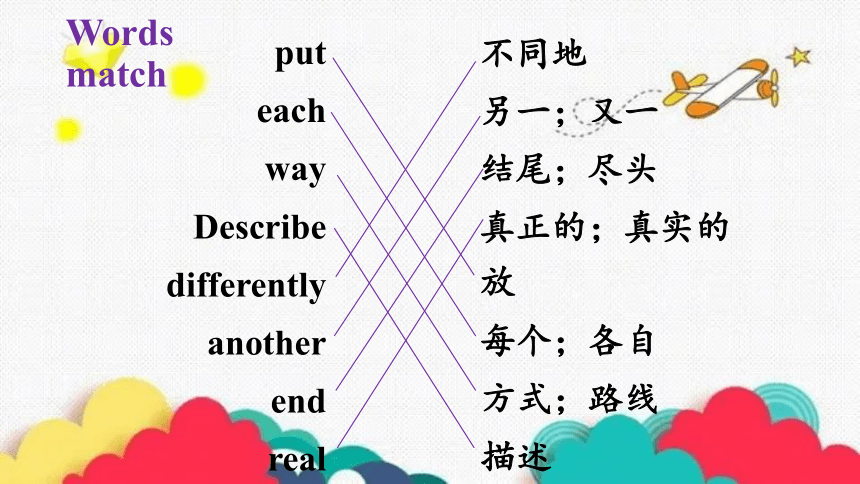

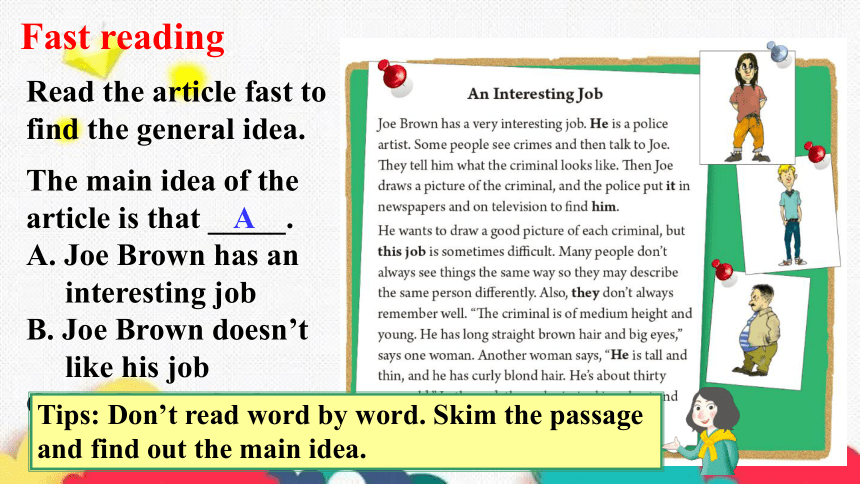
文档简介
(共31张PPT)
Unit 9
What does he look like
Section B 2a-2c
n. 艺术家
artist
n. 犯罪活动
crime
n. 罪犯
criminal
v. 放
put
adj&pron. 每个;各自
each
v. 方式;路线
way
v. 描述
describe
adv. 不同的
differently
adj&pron. 另一;又一
another
n. 结尾;尽头
end
adj. 真正的;真实的
real
n. 牛仔裤
jeans
n. 画画
draw a picture
n. 最后
in the end
n. 首先;第一
first of all
put
each
way
Describe
differently
another
end
real
放
每个;各自
方式;路线
描述
不同地
另一;又一
结尾;尽头
真正的;真实的
Words
match
Complete the chart with words of the opposite meaning.
young
thin
tall
long
curly
old
heavy/fat
short
short
straight
2a
Read the article fast to find the general idea.
Fast reading
The main idea of the article is that _____.
A. Joe Brown has an
interesting job
B. Joe Brown doesn’t
like his job
C. Joe Brown look
is good
A
Tips: Don’t read word by word. Skim the passage and find out the main idea.
Careful reading
Read Para. 1 and answer the following questions.
Who draws the pictures
Joe Brown.
How can he help the police find the criminal
What is his job
A police artist.
People see crimes and talk to Joe.
Then he draws a picture of the criminal.
The police put it in newspapers and on television to find the criminal.
an interesting job
Read Para. 2 and completer the mind map.
one woman
______________ and young, __________________ hair,
big eyes
another woman
______ and thin,
____________ hair,
about thirty years old
the really criminal
short and ______
old man,
___________hair
medium height
long straight brown
tall
curly blonde
heavy
short black
the criminal
Why is Joe’s job difficult
Read the newspaper article. Which picture shows the real criminal
2b
An Interesting Job
Joe Brown has a very interesting job.
He is a police artist. Some people see
crimes and then talk to Joe. They tell
him what the criminal looks like. Then
Joe draws a picture of the criminal, and
the police put it in newspapers and on
television to find him.
He wants to draw a good picture of each
criminal, but this job is sometimes difficult.
Many people don’t always see things the same way so they may describe the same person differently. Also, they don’t always remember well. “The criminal is of medium build and young. He has long straight brown hair and big eyes,” says one woman.
Another woman says, “He is tall and thin, and he has curly blond hair. He’s about thirty years old.” In the end, the real criminal is a short and heavy old man, and he has short black hair!
1.What does Joe Brown do
2. Is this job easy or difficult Why
He is a police artist.
Read the article again and answer
the questions.
Difficult. Because many people don’t always see things the same way so they may describe the same person differently.
Read the article again and write what the words in bold refer to.
1. He =_________________________________
2. it = _________________________________
3. him = ________________________________
4. this = ________________________________
5. they =________________________________
________________________________
6. He = _________________________________
Joe Brown
the picture of the criminal
the criminal
drawing a good picture of each criminal
many people (who see and describe the criminals)
The criminal
2c
Describe the following people
according to 2b.
He is of ________________
and young.
He has_________________
_______________________.
medium build
long straight
black hair and big eyes
He is of ________________.
He has ______________
and _____________.
He wears _______________.
medium height
a long nose
small eyes
a brown jacket
He is _____and thin.
He has _____________hair.
He is ____________ years
old.
tall
curly blond
about thirty
He is short and ________.
He has ___________hair.
heavy
short black
Language points
He wants to draw a good picture of each criminal. 他想画好每个罪犯的画像。
each adj. & pron. 每个;各自
(1) each作形容词,用于名词前作定语,修饰可数名词单数。
Each school has its own library. 每一所学校都有它自己的图书馆。
(2) each还可作代词:
①可单独作主语,也可接介词of,“each of +复数名词/代词”作主语时, 谓语动词通常用单数形式。
There are five boys in this group and each has his own answer. 这个小组有五个男孩,每个人都有自己的答案。
Each of us likes English. 我们每一个人都喜欢英语。
②可用作复数名词或代词的同位语。注意:each作主语(复数)的同位语时,谓语动词应为复数。
You have to visit them each (=each of them). 你得拜访他们每一个人。
We each (=Each of us) have different problems. 我们各自有不同的问题。
【易混辨析】each与every
each 常指两者或两者以上中的每一个,侧重整体中的个体。既可作形容词,又可作代词(可单独使用,也可与of连用)。 Every/Each student is in the classroom and each does his homework. 所有学生都在教室里,各自做着自己的作业。
every 指三者或三者以上中的每一个,侧重整体。every是限定词,只能作定语,不可单独使用,也不可与of连用。
2. Another woman says, “He is tall and thin…” 另一位女士说:“他又高又瘦 ……”
another adj. & pron. 另一;又一
(1)another在句中作形容词,指三者或三者以上中的“另一个”,修饰可数名词单数。
We need another computer. 我们还需要一台电脑。
(2)another还可作代词,泛指同类事物中三者或三者以上中的“另一个;又一个”,代替可数名词单数。
I don’t like this sweater. Please show me another. 我不喜欢这件毛衣,请给我看另一件。
【拓展延伸】
another常用于“another+基数词(大于1)+可数名词复数”结构,相当于“基数词(大于1)+more+可数名词复数”。
We’ll have to wait another two months for the result.= We’ll have to wait two more months for the result. 我们还得再等两个月才能知道结果。
3. In the end, the real criminal is a short and heavy old man, and he has short black hair! 最后,真正的罪犯是一个又矮又胖的老人,而且他留的是黑色短发!
in the end 最后
in the end 是固定短语,相当于at last或finally ,常放在句首或句尾作状语。其中end是名词,意为“结尾;尽头”。
In the end, we got to the top of the mountain. 最后,我们到达了山顶。
【拓展延伸】end构成的常见短语:
(1)at the end of 在……的尽头/末尾,后既可跟表示时间的名词,也可跟表示地点的名词。
You can see the post office at the end of the street. 你可以在街道的尽头看见邮局。
The film will be on at the end of March. 这部电影将在三月底上映。
(2)by the end of 到……末为止
What will the world be like by the end of the 21st century 到21世纪末世界将会是什么样?
Unit 9
What does he look like
Section B 2a-2c
n. 艺术家
artist
n. 犯罪活动
crime
n. 罪犯
criminal
v. 放
put
adj&pron. 每个;各自
each
v. 方式;路线
way
v. 描述
describe
adv. 不同的
differently
adj&pron. 另一;又一
another
n. 结尾;尽头
end
adj. 真正的;真实的
real
n. 牛仔裤
jeans
n. 画画
draw a picture
n. 最后
in the end
n. 首先;第一
first of all
put
each
way
Describe
differently
another
end
real
放
每个;各自
方式;路线
描述
不同地
另一;又一
结尾;尽头
真正的;真实的
Words
match
Complete the chart with words of the opposite meaning.
young
thin
tall
long
curly
old
heavy/fat
short
short
straight
2a
Read the article fast to find the general idea.
Fast reading
The main idea of the article is that _____.
A. Joe Brown has an
interesting job
B. Joe Brown doesn’t
like his job
C. Joe Brown look
is good
A
Tips: Don’t read word by word. Skim the passage and find out the main idea.
Careful reading
Read Para. 1 and answer the following questions.
Who draws the pictures
Joe Brown.
How can he help the police find the criminal
What is his job
A police artist.
People see crimes and talk to Joe.
Then he draws a picture of the criminal.
The police put it in newspapers and on television to find the criminal.
an interesting job
Read Para. 2 and completer the mind map.
one woman
______________ and young, __________________ hair,
big eyes
another woman
______ and thin,
____________ hair,
about thirty years old
the really criminal
short and ______
old man,
___________hair
medium height
long straight brown
tall
curly blonde
heavy
short black
the criminal
Why is Joe’s job difficult
Read the newspaper article. Which picture shows the real criminal
2b
An Interesting Job
Joe Brown has a very interesting job.
He is a police artist. Some people see
crimes and then talk to Joe. They tell
him what the criminal looks like. Then
Joe draws a picture of the criminal, and
the police put it in newspapers and on
television to find him.
He wants to draw a good picture of each
criminal, but this job is sometimes difficult.
Many people don’t always see things the same way so they may describe the same person differently. Also, they don’t always remember well. “The criminal is of medium build and young. He has long straight brown hair and big eyes,” says one woman.
Another woman says, “He is tall and thin, and he has curly blond hair. He’s about thirty years old.” In the end, the real criminal is a short and heavy old man, and he has short black hair!
1.What does Joe Brown do
2. Is this job easy or difficult Why
He is a police artist.
Read the article again and answer
the questions.
Difficult. Because many people don’t always see things the same way so they may describe the same person differently.
Read the article again and write what the words in bold refer to.
1. He =_________________________________
2. it = _________________________________
3. him = ________________________________
4. this = ________________________________
5. they =________________________________
________________________________
6. He = _________________________________
Joe Brown
the picture of the criminal
the criminal
drawing a good picture of each criminal
many people (who see and describe the criminals)
The criminal
2c
Describe the following people
according to 2b.
He is of ________________
and young.
He has_________________
_______________________.
medium build
long straight
black hair and big eyes
He is of ________________.
He has ______________
and _____________.
He wears _______________.
medium height
a long nose
small eyes
a brown jacket
He is _____and thin.
He has _____________hair.
He is ____________ years
old.
tall
curly blond
about thirty
He is short and ________.
He has ___________hair.
heavy
short black
Language points
He wants to draw a good picture of each criminal. 他想画好每个罪犯的画像。
each adj. & pron. 每个;各自
(1) each作形容词,用于名词前作定语,修饰可数名词单数。
Each school has its own library. 每一所学校都有它自己的图书馆。
(2) each还可作代词:
①可单独作主语,也可接介词of,“each of +复数名词/代词”作主语时, 谓语动词通常用单数形式。
There are five boys in this group and each has his own answer. 这个小组有五个男孩,每个人都有自己的答案。
Each of us likes English. 我们每一个人都喜欢英语。
②可用作复数名词或代词的同位语。注意:each作主语(复数)的同位语时,谓语动词应为复数。
You have to visit them each (=each of them). 你得拜访他们每一个人。
We each (=Each of us) have different problems. 我们各自有不同的问题。
【易混辨析】each与every
each 常指两者或两者以上中的每一个,侧重整体中的个体。既可作形容词,又可作代词(可单独使用,也可与of连用)。 Every/Each student is in the classroom and each does his homework. 所有学生都在教室里,各自做着自己的作业。
every 指三者或三者以上中的每一个,侧重整体。every是限定词,只能作定语,不可单独使用,也不可与of连用。
2. Another woman says, “He is tall and thin…” 另一位女士说:“他又高又瘦 ……”
another adj. & pron. 另一;又一
(1)another在句中作形容词,指三者或三者以上中的“另一个”,修饰可数名词单数。
We need another computer. 我们还需要一台电脑。
(2)another还可作代词,泛指同类事物中三者或三者以上中的“另一个;又一个”,代替可数名词单数。
I don’t like this sweater. Please show me another. 我不喜欢这件毛衣,请给我看另一件。
【拓展延伸】
another常用于“another+基数词(大于1)+可数名词复数”结构,相当于“基数词(大于1)+more+可数名词复数”。
We’ll have to wait another two months for the result.= We’ll have to wait two more months for the result. 我们还得再等两个月才能知道结果。
3. In the end, the real criminal is a short and heavy old man, and he has short black hair! 最后,真正的罪犯是一个又矮又胖的老人,而且他留的是黑色短发!
in the end 最后
in the end 是固定短语,相当于at last或finally ,常放在句首或句尾作状语。其中end是名词,意为“结尾;尽头”。
In the end, we got to the top of the mountain. 最后,我们到达了山顶。
【拓展延伸】end构成的常见短语:
(1)at the end of 在……的尽头/末尾,后既可跟表示时间的名词,也可跟表示地点的名词。
You can see the post office at the end of the street. 你可以在街道的尽头看见邮局。
The film will be on at the end of March. 这部电影将在三月底上映。
(2)by the end of 到……末为止
What will the world be like by the end of the 21st century 到21世纪末世界将会是什么样?
同课章节目录
- Unit 1 Can you play the guitar?
- Section A
- Section B
- Unit 2 What time do you go to school?
- Section A
- Section B
- Unit 3 How do you get to school?
- Section A
- Section B
- Unit 4 Don't eat in class.
- Section A
- Section B
- Unit 5 Why do you like pandas?
- Section A
- Section B
- Unit 6 I'm watching TV.
- Section A
- Section B
- Review of Units 1-6
- Unit 7 It's raining!
- Section A
- Section B
- Unit 8 Is there a post office near here?
- Section A
- Section B
- Unit 9 What does he look like?
- Section A
- Section B
- Unit 10 I'd like some noodles.
- Section A
- Section B
- Unit 11 How was your school trip?
- Section A
- Section B
- Unit 12 What did you do last weekend?
- Section A
- Section B
